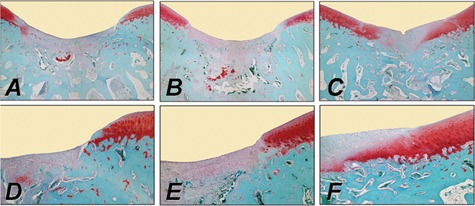Figure 2.

Improvement of cartilage repair in a rabbit osteochondral defect model in the trochlear groove by combined ex vivo gene transfer of human insulin-like growth factor I (hIGF-I) and fibroblast growth factor-2 (hFGF-2) in NIH 3T3 fibroblasts that were then embedded in alginate spheres and transplanted into the defects. Histological appearance of osteochondral defects following treatment with a lacZ implant (left column: A, D), an IGF-I implant (middle column: B, E), and an IGF-I/FGF-2 implant (right column: C, F) stained with safranin O. Images (D-F; 40x) are magnified views of A through C (20x), illustrating the area of integration between the repair tissue (on the left side of D-F) with the adjacent normal articular cartilage (on the right side of D-F). Implants remained in a subchondral location and are visible at the bottom of images (A, B). Transplantation of the cotransfected IGF-I/FGF-2 implants accelerated the formation of the subchondral bone and improved articular cartilage repair in a magnitude that was larger than with IGF-I alone or when compared to lacZ implants after 3 weeks in vivo.
